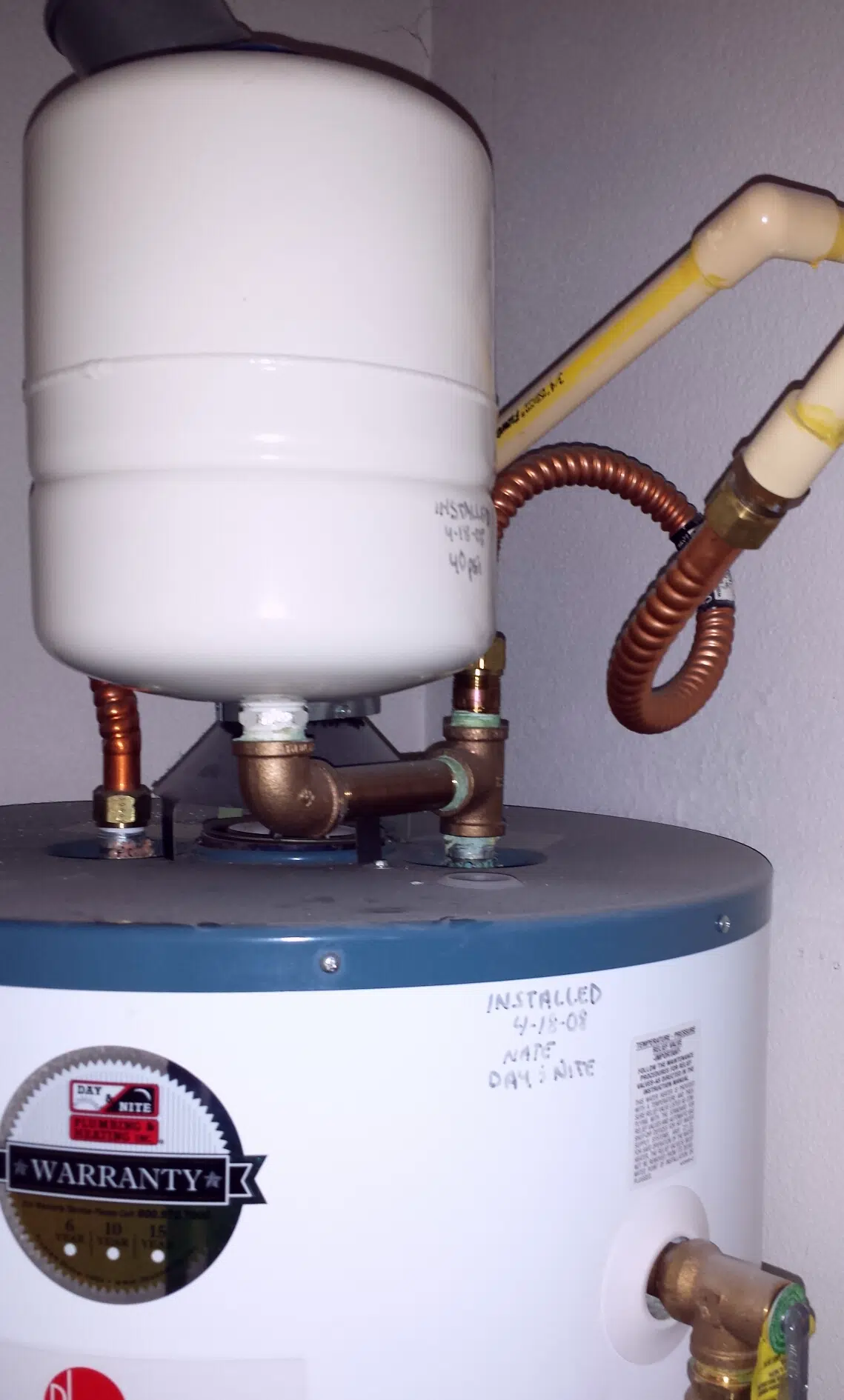Water Heaters are so common most people feel pretty familiar with them, but when a technician comes out for a water heater problem, suddenly things seem a little more complicated than they use to be. Commonly, water heaters are not installed to current code requirements. As good, professional technicians, it’s our responsibility to make the home owner aware of such things, and explain why they might be needed, so the home owner can make an informed buying decision. Case in point, the Thermal Expansion Tank. It’s that thing on top of the water heater about the size of a coffee can, and we get a lot of questions about them. Actually, they come in many different sizes, which differ based on water pressure, the amount of water that is heated, and the temperature the water is heated to.
Of all the options for an installation of a water heater, the number one topic of debate is the necessity of the Thermal Expansion Tank. In my mind there’s no question about it. An expansion tank should be installed with every water heater every time. So often the thought is, “ my old water heater never had one, so why do I all of a sudden need one now?” It’s a simple matter of physics. Most people understand that when water is heated it expands. So, If water is expanding , where does this “extra” water go? The Expansion Tank. When sized right and installed correctly, it’s the expansion tank’s job to take on this “extra” water caused by thermal expansion. Thermal expansion tanks have a rubber bladder in them with an “air cushion” on one side and the other side connected to the water piping. When thermal expansion occurs, the water presses against the bladder and compresses the air cushion on the other side of the bladder to allow for that “extra” water to expand into the thermal expansion tank. When someone opens a faucet the compressed air presses on the bladder in the other direction to push the excess water back into the plumbing system. This device sized, tuned, and installed correctly minimizes excess pressure caused when water expands from being heated. Okay, so that’s the “what”. Now here’s the “why”.
 In the past, expansion tanks were not as necessary as they are today. Back then, when thermal expansion would occur it would push the expanding water back through the plumbing system and into the city main. Today’s plumbing systems are more sophisticated, utilizing controls and other devices for efficiency and comfort. This often creates what is called a “closed system”, which prevents the expanding water from traveling back in the opposite direction. Many utilities have also been adding check valves to their water meters, so that once city water passes your meter it cannot flow back into the city supply. This makes your entire home a closed system. Since all of these things could potentially play a part in your plumbing system, the water is essentially trapped in this closed system until someone opens a valve. Imagine what happens when the water is heated in this closed system. With nowhere to go the pressure begins to increase substantially as the water tries to expand. This pressure could go well above normal working pressure, and could exceed 150-psi (pounds per square inch) if it weren’t for the safety relief valve. This valve is designed to open and relieve pressure from the water heater when it goes above 150-psi, draining to the floor, then outside the building where it won’t cause water damage. A system without a working expansion tank can face potentially large swings in water pressure, taxing the glass lining of the water heater, and other plumbing fixtures and components throughout the whole building.
In the past, expansion tanks were not as necessary as they are today. Back then, when thermal expansion would occur it would push the expanding water back through the plumbing system and into the city main. Today’s plumbing systems are more sophisticated, utilizing controls and other devices for efficiency and comfort. This often creates what is called a “closed system”, which prevents the expanding water from traveling back in the opposite direction. Many utilities have also been adding check valves to their water meters, so that once city water passes your meter it cannot flow back into the city supply. This makes your entire home a closed system. Since all of these things could potentially play a part in your plumbing system, the water is essentially trapped in this closed system until someone opens a valve. Imagine what happens when the water is heated in this closed system. With nowhere to go the pressure begins to increase substantially as the water tries to expand. This pressure could go well above normal working pressure, and could exceed 150-psi (pounds per square inch) if it weren’t for the safety relief valve. This valve is designed to open and relieve pressure from the water heater when it goes above 150-psi, draining to the floor, then outside the building where it won’t cause water damage. A system without a working expansion tank can face potentially large swings in water pressure, taxing the glass lining of the water heater, and other plumbing fixtures and components throughout the whole building.
The most common problem with expansion tanks is incorrect installation. Our technicians commonly run across expansion tanks that have failed prematurely and/or were installed incorrectly. Thermal expansion tanks must be properly sized, located, tuned, and checked annually during the annual water heater maintenance. A good installation will help maintain minimal pressure increase caused by thermal expansion, can reduce water hammer, and help protect plumbing components from strain. An incorrect installation can be as bad as having no expansion tank at all, and sometimes worse. Incorrect installation can be the cause of everything from high water bills and water hammer, to excessive wear on the water heater and plumbing fixtures.
There are some circumstances where the Uniform Plumbing Code (608.3 UPC 2009,current adopted plumbing code for Washington State) allows for not installing an expansion tank. A typical example is in areas where they have not yet installed a check valve at the meter and the water heater is not on a closed system. In other words the water can travel back through the meter into the city side as the water heats up and expands. When water is expanding due to heat and can freely travel unobstructed with minimal increase to the system pressure then technically an expansion tank is not needed. If ever this kind of system is inadvertently or purposely changed into a closed system, an expansion tank should be installed to protect the system and the water heater.
So, do you really need that thing on the top of your water heater? Ask a good, responsible, professional plumber… before you decide.
Bruce Davis Jr.
General Manager
Day & Nite Plumbing & Heating, Inc.
Bruce is a second generation plumber and HVAC technician. He earned his Commercial Plumbing License and later became N.A.T.E. Certified and E.P.A. Refrigerant Certified for HVAC service and repair for commercial and residential HVAC appliances. Bruce has years of experience as an HVAC Technician, Boiler Technician, and Plumber. He is now General Manager for the company he has been with his entire career and oversees the Plumbing, Heating, and Air Conditioning business for Day & Nite Plumbing & Heating, Inc.












